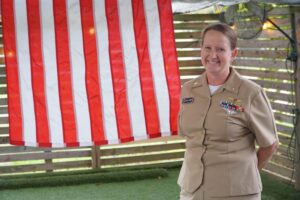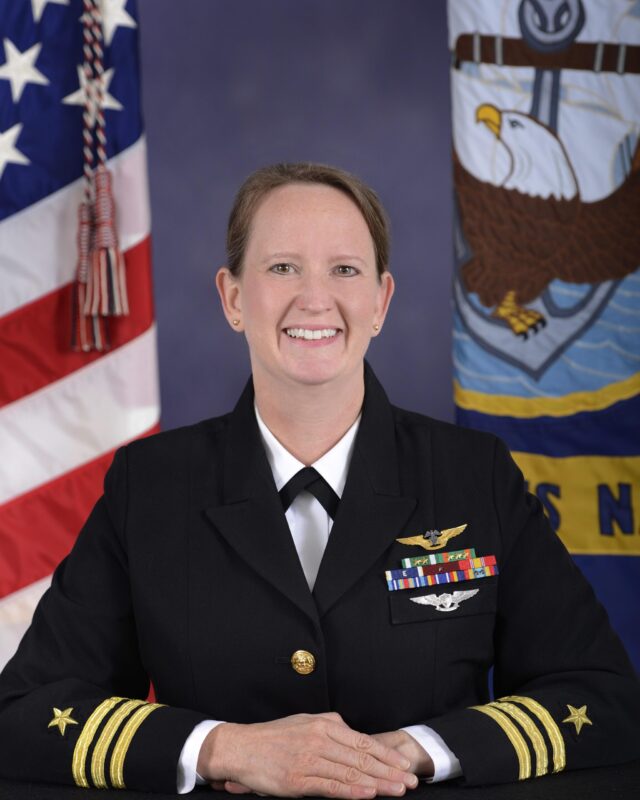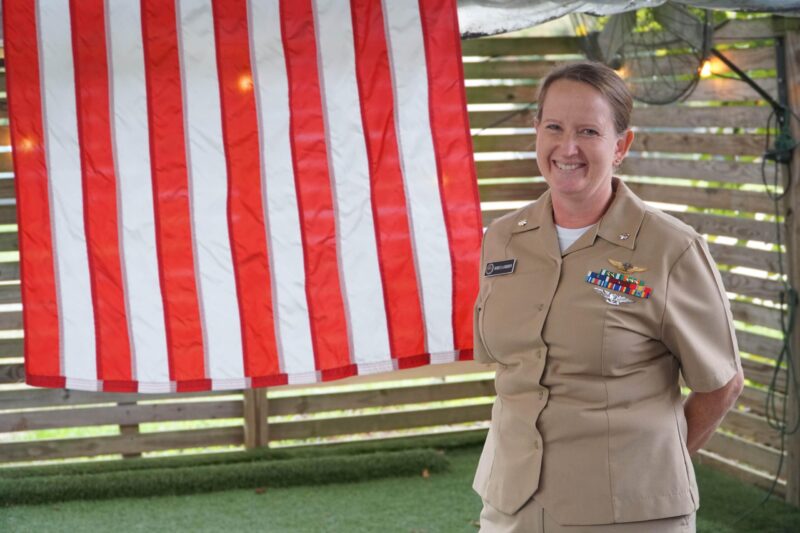
Cmdr. Rebecca Anderson, the military assistant program manager for logistics at Naval Air Systems Command’s Airborne Strategic Command, Control and Communications Program Office (PMA-271).
NAVAL AIR STATION PATUXENT RIVER, MD: This year marks the 50th anniversary of women in naval aviation, an anniversary that celebrates when the first women began flight school in Pensacola, Florida, back in 1973.
In the years since those “first six” donned their flight suits, women’s role in naval aviation has expanded to serve and lead in every aspect of the enterprise.
“They fly and fight in all strike missions, hunt submarines, protect the integrity of our nuclear triad, supply essential cargo and personnel to every corner of the globe, and rescue those in distress at sea and ashore. They command aircraft carriers, carrier air wings, squadrons, and missions to space,” according to U.S. Navy’s “50 Years of Women Flying in the Navy.” “In 2023, we reflect on our Naval Aviation history and pay tribute to all of our women Naval Aviators- “The First Six”, and all those who have come after them. Our Nation and our Navy is stronger because of their service.”
A lesser known part of this history is the role that women have played in support of the Take Charge and Move Out (TACAMO) mission, which links the president and secretary of defense with naval ballistic missile forces during times of crisis. Throughout the years, TACAMO has been ahead of the curve in its inclusion and promotion of women, said Vern Lochausen, a retired commodore and longtime member of the TACAMO community who now serves as a consultant for PMA-271.
As far back as 1989, women made up roughly one-fourth of the operational squadrons that fly the TACAMO mission, according to an April 1989 article in Proceedings magazine. They helped pave the way for women in other aviation communities and advocate for women to be allowed to serve in combat.
Among there were women such as the first TACAMO squadron pilots, Lt. Janine Igou and Lt. Sue Harter. TACAMO women also included Vice Adm. Nora Tyson, the first woman to command a carrier strike group and the first to serve as 3rd Fleet commander; Rear Adm. Margaret “Peg” Klein, the first woman commandant of midshipmen at the U.S. Naval Academy; and Vice Adm. Robin Braun, the first woman to command the U.S. Navy Reserve.
Today, that tradition is carried on by the women still serving the TACAMO mission, including those at Naval Air Systems Command’s Airborne Strategic Command, Control and Communications Program Office (PMA-271). The program office is an acquisition command that delivers capabilities to the warfighter by maintaining the E-6B Mercury fleet. It’s also fielding the next generation of TACAMO aircraft through TACAMO Recapitalization Program, E-XX. PMA-271’s mission is to deliver and support survivable, reliable and endurable airborne command, control and communications for the president, secretary of defense and U.S. Strategic Command.
They include Cmdr. Rebecca Anderson, PMA-271’s military assistant program manager for logistics (APML). Anderson, a native of Catonsville, Maryland, enlisted in the Navy 20 years ago, working in maintenance and logistics and earning her officer commission in 2010. She joined the PMA-271 team at Naval Air Station Patuxent River, Maryland, in 2022.
She has made an indelible impact on the E-6B Mercury fleet’s depot reform, leading the team to reduce turnaround time from 595 days to 372 days.
For the 50th anniversary of women in naval aviation, Anderson answered some questions about her journey as part of the naval aviation community.
Why did you join the Navy? I joined the Navy because I was bored as a teacher, where I taught various computer courses at an adult technical school. They were short, six-week-long classes and, despite enjoying the interactions with the students, the material was the same again and again. I have always loved to travel and felt the military would provide that opportunity.
Why did you decide to pursue a career in naval maintenance and logistics? I began my Navy career as an avionics technician. My dad worked for the airlines and I grew up with a fascination of airplanes. My first command was the Aircraft Intermediate Maintenance Department at Naval Air Station Oceana, where I learned to run and fix gear across maintenance benches. It wasn’t until I deployed for the first time aboard the aircraft carrier USS George Washington (CVN 73) that I truly fell in love with what I do. I’m passionate about doing things that make a difference. I may have had a very small part in the overall mission, but I knew that I contributed and wanted to have a bigger role. I looked at the leaders around me and began to research earning a commission. I applied to Officer Candidate School in 2009 while on deployment on the aircraft carrier USS Dwight D. Eisenhower (CVN 69) and, thankfully, was selected upon my first submission.
What’s been your favorite job in your naval career so far? Serving as the maintenance office at Strategic Communications Wing 1 (SCW-1) at Tinker Air Force Base, Oklahoma. It was the first position I held where I felt I made a difference on the larger scale as I’d dreamed of doing as a young second class petty officer. I love the TACAMO mission. In this role, I briefed the SCW-1 commodore regularly on the status of our aircraft and improvement initiatives.
Have you had any mentors along the way? My first mentor was Cmdr. Mike Barriere. He was the maintenance material control officer on the Dwight D. Eisenhower and was instrumental in my selection as an aviation maintenance duty officer. He also came to Naval Station Newport, Rhode Island, for my commissioning and continued to mentor me until he retired. Capt. Michael Mulhern is my current mentor. He was instrumental in my growth as a young Lieutenant on the aircraft carrier USS Harry S. Truman (CVN 75) and continued to mentor me from afar through my lieutenant commander tours and selection for commander.
What led you to join the TACAMO community? I knew of others who had been in TACAMO. I looked up the “doomsday plane” on YouTube and was fascinated by what I learned. Once I was in place as the wing maintenance officer at SCW-1, I never looked back. I have worked to develop the path I am currently on to continue my support of this critical national security mission.
What’s your day-to-day like as the APML for PMA-271? As the military APML at PMA-271, I conduct and attend a lot of meetings. That may sound monotonous, and some days it can be, but most days I’m leading a team of teams to resolve issues in the fleet or the depot line. The teams I work with are filled with a wealth of knowledge and expertise. I collaborate with them to find the best paths forward and deliver solutions to the fleet, ensuring that they can continue to execute their mission. These teams include people from NAVAIR, the Fleet Support Team, SCW-1, Boeing, our contractor logistics support provider, Boston Consulting Group, Northrup Grumman and more.
What’s your favorite part of your job? I enjoy working with the teams to drive us forward toward our common goal of aircraft readiness.
What skills and/or traits have helped you be successful in your career? Humility and relationship development. My enlisted time spanned just short of seven years. I have never turned a wrench on an aircraft, and yet I have led maintenance efforts on multiple platforms: the F/A-18 Super Hornet, E-2D Advanced Hawkeye, P-8A Poseidon, H-60 Seahawk and the E-6B Mercury. I have humbled myself and built relationships with maintenance experts, and I owe any success to them. Leading teams of teams, the path forward can be both dynamic and challenging. Listening to each entity and understanding the different constraints and implications has been essential.
Have you faced any unique challenges as a woman in the Navy? I have never felt discrimination in the Navy. In my experience, those who work hard are part of the team and instrumental to mission accomplishment, regardless of their gender.
Do you have any advice for women who want to pursue a career in the Navy and/or Navy logistics and maintenance? Do it! Do your job. Work hard. Let your work speak for itself. I offer that same advice to anyone wanting to pursue a naval career.
With this year marking the 50th anniversary of women in naval aviation, what do you think about the contributions that women have made to the Naval Aviation Enterprise over the last 50 years? I am thankful to be here and contribute to the NAE mission. I understand there have been women who have paved the way for the opportunities I have had in my career.
Anything else you would like to share? I’m looking forward to the day when each individual is valued for their accomplishments and demographics are not part of the narrative. I want my work to simply speak for itself.
PMA-271 consultant Vern Lochausen contributed to this report.

Cmdr. Rebecca Anderson

Cmdr. Rebecca Anderson, the military assistant program manager for logistics at Naval Air Systems Command’s Airborne Strategic Command, Control and Communications Program Office (PMA-271).


